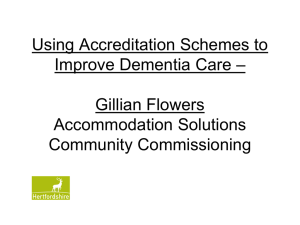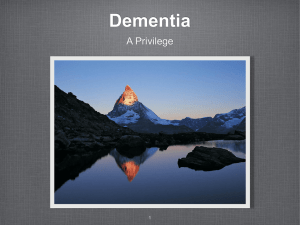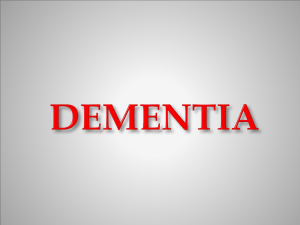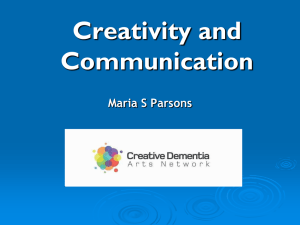Doncaster Outcomes Based Accountability Template for Dementia
advertisement
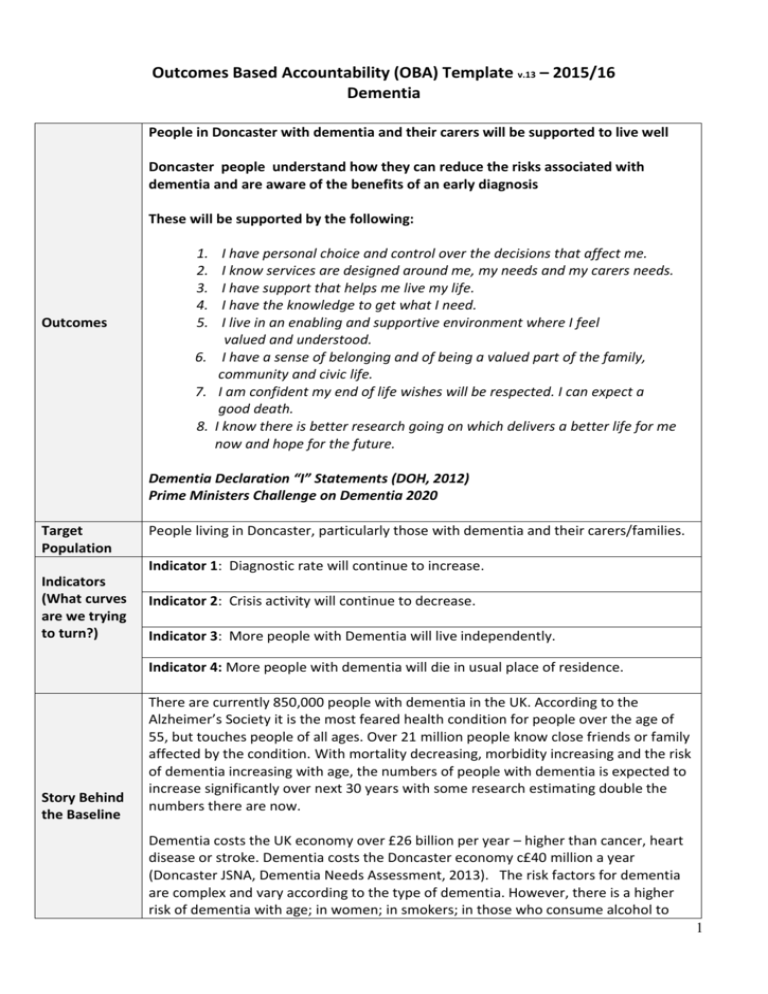
Outcomes Based Accountability (OBA) Template v.13 – 2015/16 Dementia People in Doncaster with dementia and their carers will be supported to live well Doncaster people understand how they can reduce the risks associated with dementia and are aware of the benefits of an early diagnosis These will be supported by the following: Outcomes 1. 2. 3. 4. 5. I have personal choice and control over the decisions that affect me. I know services are designed around me, my needs and my carers needs. I have support that helps me live my life. I have the knowledge to get what I need. I live in an enabling and supportive environment where I feel valued and understood. 6. I have a sense of belonging and of being a valued part of the family, community and civic life. 7. I am confident my end of life wishes will be respected. I can expect a good death. 8. I know there is better research going on which delivers a better life for me now and hope for the future. Dementia Declaration “I” Statements (DOH, 2012) Prime Ministers Challenge on Dementia 2020 Target Population People living in Doncaster, particularly those with dementia and their carers/families. Indicator 1: Diagnostic rate will continue to increase. Indicators (What curves are we trying to turn?) Indicator 2: Crisis activity will continue to decrease. Indicator 3: More people with Dementia will live independently. Indicator 4: More people with dementia will die in usual place of residence. Story Behind the Baseline There are currently 850,000 people with dementia in the UK. According to the Alzheimer’s Society it is the most feared health condition for people over the age of 55, but touches people of all ages. Over 21 million people know close friends or family affected by the condition. With mortality decreasing, morbidity increasing and the risk of dementia increasing with age, the numbers of people with dementia is expected to increase significantly over next 30 years with some research estimating double the numbers there are now. Dementia costs the UK economy over £26 billion per year – higher than cancer, heart disease or stroke. Dementia costs the Doncaster economy c£40 million a year (Doncaster JSNA, Dementia Needs Assessment, 2013). The risk factors for dementia are complex and vary according to the type of dementia. However, there is a higher risk of dementia with age; in women; in smokers; in those who consume alcohol to 1 excess; with an unhealthy diet; in obesity and in those who do little physical exercise and if the mind is not kept active. There is emerging evidence to suggest that a proportion of new cases of dementia could be prevented or onset delayed by paying attention to vascular risk factors; ‘What is good for your heart is good for your head’. Offering health checks will ensure awareness of signs and symptoms of dementia is raised and where appropriate people are referred to GP’s. Health checks also offer general lifestyle advice which will contribute to the prevention of dementia. Measuring the uptake of health checks will be a good measure to demonstrate people are engaging in the prevention agenda. Diagnosis Over the last few years there has been a national focus on improving diagnostic rates with the Prime Minister setting an ambition of 67% by 2015. The national average is currently (February 2015) 59%. As of February 2015 there are estimated to be 4023 people with dementia in Doncaster with 2443 people being formerly diagnosed giving a diagnostic rate of 60.73%. Empowering people to make informed choices on receiving a diagnosis will remain key moving forward. If people do decide to have an assessment for a diagnosis that access, experience and outcome should be equitable across Doncaster irrespective of age, disability or ethnicity. Measuring diagnostic rates will be a good measure to demonstrate people are being empowered to seek a diagnosis Crisis People with dementia and carers inform us that their outcomes and experiences of services are generally good but not so good before entering and leaving services and especially when things go wrong. There were 2084 admissions of people with dementia to acute beds in 2013/14 and crisis activity on analysis has often proved to be concerning carer or situational factors. There are 33,150 carers in Doncaster and 7301 of these are people aged over 65. Effective care and support of both the person with dementia and their carers is crucial to prevent crisis. Measuring crisis episodes will be a good indicator to demonstrate people are managing to live well. Living Independently As diagnostic rates increase the challenge will be to support people with dementia and their families/carers to live active and independent lives. There are currently 2100 residential beds in Doncaster and the average length of stay in those beds is double that to those in comparative areas. As much as 69% of the beds occupied will be with people with some form of dementia/cognitive impairment. Measuring the number of people with dementia living at home, the number of people with dementia making use of assistive technology and direct payments and reducing the length of stay in residential care are good indicators to demonstrate people are 2 living longer at home and more independently. A proxy measure is also the number of safeguarding incidents that involve people with dementia. End of Life Too many people continue to die in hospital often spending the last few days or even hours in hospital. Nationally 51% of deaths are in hospital. In Doncaster the average is 56% with the difference equating to 147 deaths. Approximately 500 people per year die with dementia. Measuring the number of people that die in hospital as a proportion of all deaths is a basic measure however measuring the number of people with dementia with an advanced care plan will support this measure. Data Development Agenda Data development is now more robust than ever before with the abundance of national policy documents and guidance and the availability of activity data now available on a monthly basis. Some of the key policy documents and guidance are listed below. Dementia overview http://pathways.nice.org.uk/pathways/dementia Dementia diagnosis and assessment http://pathways.nice.org.uk/pathways/dementia/dementia-diagnosis-andassessment Department of Health: Living Well With Dementia: a national dementia strategy https://www.gov.uk/government/uploads/system/uploads/attachment_data/f ile/168220/dh_094051.pdf https://www.gov.uk/government/publications/prime-ministers-challenge-ondementia-2020 SCIE: The Social Care Institute for Excellence has produced a plethora of information regarding dementia friendly environments, living with dementia, understanding dementia and key resources for patients, carers and professionals. http://www.scie.org.uk/publications/dementia/resources/dementia-links.asp NHS Evidence and Choices dementia: https://www.evidence.nhs.uk/topic/dementias?q=dementia http://www.nhs.uk/conditions/dementia-guide/Pages/dementia-choices.aspx Alzheimer’s Society The Dementia Knowledge Centre contains all the key documents produced by the Society including All Party Group publication on Dementia, Dementia 2014 and Dementia Friendly Communities; A priority for everyone. http://dementiacatalogue.alzheimers.org.uk/library/libraryHome.do Leadership Alliance for the Care of Dying people (LADCP) One Chance To Get It Right is a leading document produced by a coalition of 21 national organisations that was set up to lead and provide a focus for improving the care of people who are dying and their families through “Priorities for Care”. https://www.gov.uk/government/uploads/system/uploads/attachment_data/f ile/323188/One_chance_to_get_it_right.pdf 3 National Council for Palliative Care (NCPC) Out of the shadows: End of life care for people with dementia 2009 (references the Pan Birmingham Palliative Care Network’s Supportive Care Pathway) In addition to the above locally we have a number of sources of data listed below: Dementia Joint Strategic Needs Assessment (JSNA) 2013, Public Health Observatory www.doncaster.gov.uk Service user and carer feedback, consultation and engagement Dementia provider feedback, consultation and engagement 2014/15 – OBAT performance data set Dementia Mapping and scoping of dementia services in Doncaster GP Target events Leadership workshop. Benchmarking data – South Yorkshire, Yorkshire and Humber and National comparisons. The performance measures below are designed to capture progress against the delivering Getting There; A Dementia Strategy for Doncaster 2015- 2017 and in particular the indicators listed above. Performance Measures 1. We will increase the number of people diagnosed with Dementia at Q4 2015/16 against Q4 2014/15 2. We will ensure people with Dementia have less crisis demonstrated by: Reduction in referrals requiring 4hr response time (in hours and OOH) Increase in number of carers taking up elements of the carers offer Reduction in the number of Carers requiring Emergency Respite Reduction in delayed discharges, people attending A&E, hospital admissions, re-admissions and maintain current length of stay against 14/15 outturn We will reduce the numbers of admissions and the admissions from care homes of people with dementia to acute services. We will reduce the number of PWD experiencing falls in acute care services 3. We will increase the number of people with dementia living at home. 4. We will reduce the length of stay for people in residential care. 5. We will increase the number of people with dementia receiving Direct Payments. 6. We will increase the number of people with dementia using assistive technology. 7. We will reduce the number of safeguarding incidents involving people with dementia. 8. We will reduce the % of deaths in hospital against the total % of all deaths. 9. The % of people with a diagnosis of dementia with an advanced care plan. (baseline to be reviewed from QOF at quarter 1) 10. We will ensure (through RDaSH) 90% of people with dementia will end their life in their place of choice. 4 Key Partners The input of a number of partners is required to be successful in the ambition to improve Dementia in Doncaster. They include: People with dementia and their carers Doncaster Dementia Forum DonMentia NHS Doncaster CCG including primary care Local Authority including Public Health, officers, Councillors and Members HealthWatch Emergency Services Dementia Alliances (Local, Regional and National) RDaSH NHS Foundation Trust Doncaster and Bassetlaw NHS Foundation Trust Voluntary and Third Sector providers NHS England and the Strategic Clinical Network Health Education (England) The structure below details the governance arrangements for the Dementia programme which allows the user and carer voice to both lead and be central to the dementia agenda. The Doncaster Dementia Forum (DDF) is a Service User and Carer lead Forum. The voice from this forum feeds into the Doncaster Dementia Strategic Partnership (DDSP) through the DDFs Chair. The DDSP is responsible for ensuring the delivery of this Dementia OBAT and will provide a 2 way conduit between the Health and Wellbeing Board via the Health and Social Care Transformation Board and the Health and Wellbeing Board Officers Group. Doncaster Dementia Forum Doncaster Dementia Health Group Governance Arrangements Doncaster Dementia Action Alliance Doncaster Dementia Strategic Partnership Health & Social Care Transformation Board Health and Wellbeing Board Officers Group Regional Dementia Alliance National Dementia Alliance Health and Wellbeing Board Team Doncaster 5 It is recognised much of the work related to dementia over the last few years has been heavily focused on diagnosis rates and health pathways. It is also recognised however that now more people have been diagnosed there is a challenge to support people with dementia and their carers people so they can “Live Well” with dementia. To live well includes living with personal control and choice and with access to the right support and services to enhance the ability to live independently and contribute to society. The following will help to ensure we do better in meeting the needs and expectations for Dementia can be met across the spectrum of responsibility within the partnership. What would it take to do better? 1. Maintain and further improve the engagement with service users and carers empowering them to be in control of their own lives. 2. Further develop the joint commissioning opportunities for Dementia 3. Maintain and further improve local leadership within the Doncaster community. 4. Maintain and further develop partnership working and collaboration. 5. Continue to develop as a “Dementia Friendly Community” utilising the “Four Cornerstones model” as detailed below. 6. Better understanding and use of market and service delivery intelligence 7. Improved understanding of the needs of specific demographics and/or communities of interest including BAME, people with learning disabilities and people under the age of 65 (young onset Dementia) People - how do carers, families, friends, neighbours, health and social care professionals and the wider community respond to and support people with Dementia. Places - how does the physical environment, housing, and neighbourhood and transport support people with Dementia. Resources – are there sufficient facilities for people with Dementia and are these appropriate for their needs and supportive of their capabilities. Networks – do those who support people with Dementia communicate, collaborate and plan together sufficiently well to provide the best support and to use people’s own assets’ well. 6






